Ahoy Grey Nomads
Dwarfed by the large commercial tugs plying the water of Gage Roads off Fremantle, distant observers could have been forgiven for thinking our vessel was out there to tend to the smaller shipping. Barry Wiseman reports from Perth.
Ranger Tug 29 is a beefed up version of her smaller American-built siblings and while she has a more rugged and work-type appearance, she’s filled with mobile home style comforts.
At times even referred to as a Winnebago on water, this R-29 is the first in Australasia and the largest of the Ranger Tugs fleet.
Despite the name, the vessels do not take their design from tugs at all but are in fact a down-sized Bristol Bay trawler home ported in Kent, near Seattle in the US state of Washington. The smallest of the fleet, the R-21, started its life as a 5/8th scale version of the popular fishing trawler designed by a retired fisherman, Howard Smith. In 1998, marine designer John Livingston bought the business and absorbed the product into the family boat building enterprise, Fluid Motion.
The family would spend weekends on the waters of the U.S. Northwest, crossing the Straits of Juan De Fuca with its strong tides and winds plus seas rolling in from the Pacific. Over the years changes have been made, and the fleet has expanded to include the R-25, R-27 and now the R-29. More than 1,000 Ranger Tug owners in North America enjoy life aboard these shallow-drafted, fuel-efficient boats with a difference.
The first boat to arrive in Australia was in 2008 when Sydney boating identity John Smale brought the R-21 to Queensland’s Sanctuary Cove Boat Show, attracting great interest as the crowds gathered just inside the main gates. I was there on that occasion and more than 30 boats now grace Australia’s waterways. Earlier this year Ranger Tugs Australia & New Zealand was taken over by Peter McCook who is looking to expand the dealership to all Australian states and cities in New Zealand.

Within months of the first Sanctuary Cove showing another R-21 was on the hardstand at the Mandurah Boat Show in W.A., again pulling in the crowds for local agents Craig and Michelle McAllister.
Aquatic Motor Home
“It’s been surprising how these vessels have appealed to the younger families. Originally we thought they would be more suited to mature retirees who are not in so much of rush to get to their destination, but we have sold boats to people in their late 30’s and early 40’s who have young families and just want something different and not be in a hurry,” Michelle said as we readied this R-29 at the Fremantle Sailing Club.
After this year’s Mandurah show in October the McAllisters hooked up another R-21 and headed for the Adelaide boat show, again creating much interest.
“The reception has been great. We had a lot of people who were planning to get a motor home to travel around Australia but after seeing the Ranger with its easy living and roominess they are considering that instead because they can travel on land or on the water. All models are trailerable even though you need a good sized vehicle for the R-29, and they launch and retrieve really well. You can drive on and off the trailer.”
Part of the appeal of owning a Ranger has to be its unusual appearance. It’s a vessel with a difference, even down to the artificial funnel on top of the cabin which doubles as a television antenna.
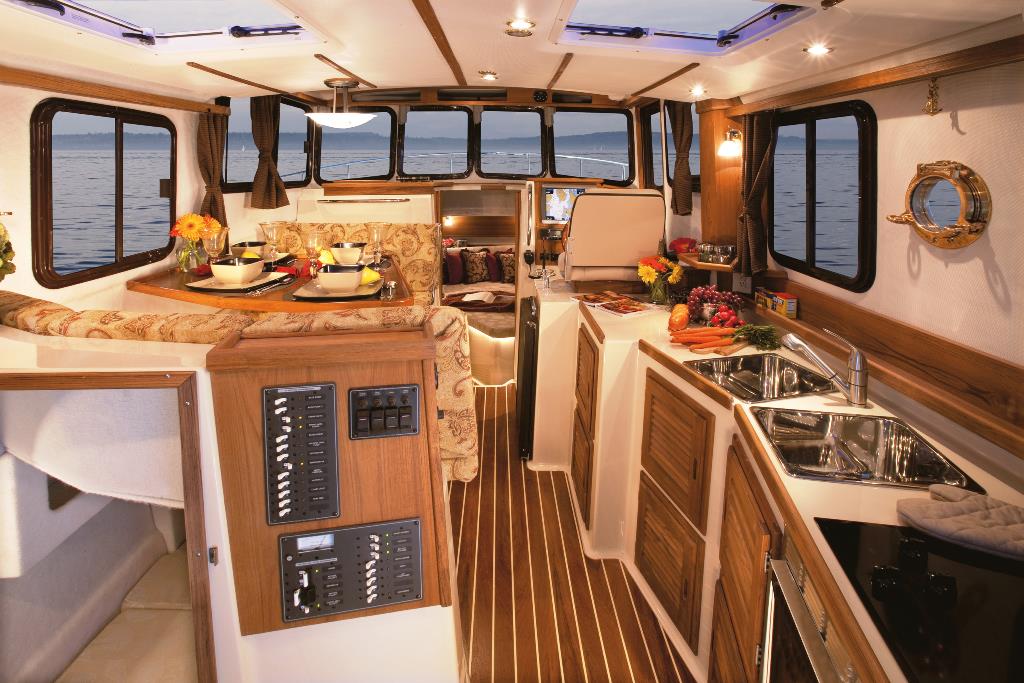
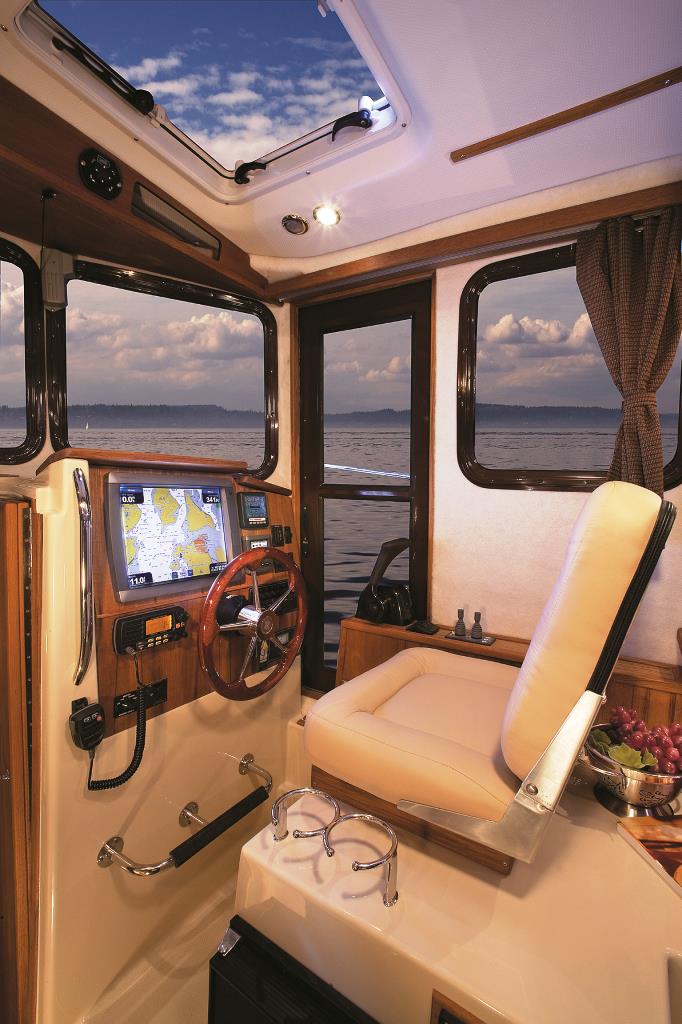
It looks very much your traditional, hard-working ocean-going fishing boat but in miniature form and with a lot more luxury. It certainly attracted lots of attention as we headed out from the Fremantle Sailing Club towards Garden Island on the western side of Cockburn Sound. This is the third Ranger Tugs vessel I have had the pleasure to review, the others being the R-21 and R-25. We grabbed the same attention on those outings with fellow boaters coming alongside for a closer look. Many are surprised to hear it’s a 5/8th version of the real thing.
On the day of this review I needed a photographic platform for the on-water shots of the R-29. Fortunately two New Zealanders on board another well-known American import obliged when I asked if I could interrupt their whiting fishing to climb aboard. It provided them with a close up look as I stepped onto the bow of their anchored vessel. They had been drifting the weed banks in the middle of the Sound and hooked a 55mm King George so decided to anchor up. They had a couple more in their bucket when I came alongside but were more than happy to oblige. The owner is a keen fisherman and admitted he was thinking of updating his vessel and the traditional fishing design of this hull had planted the seed in his mind.
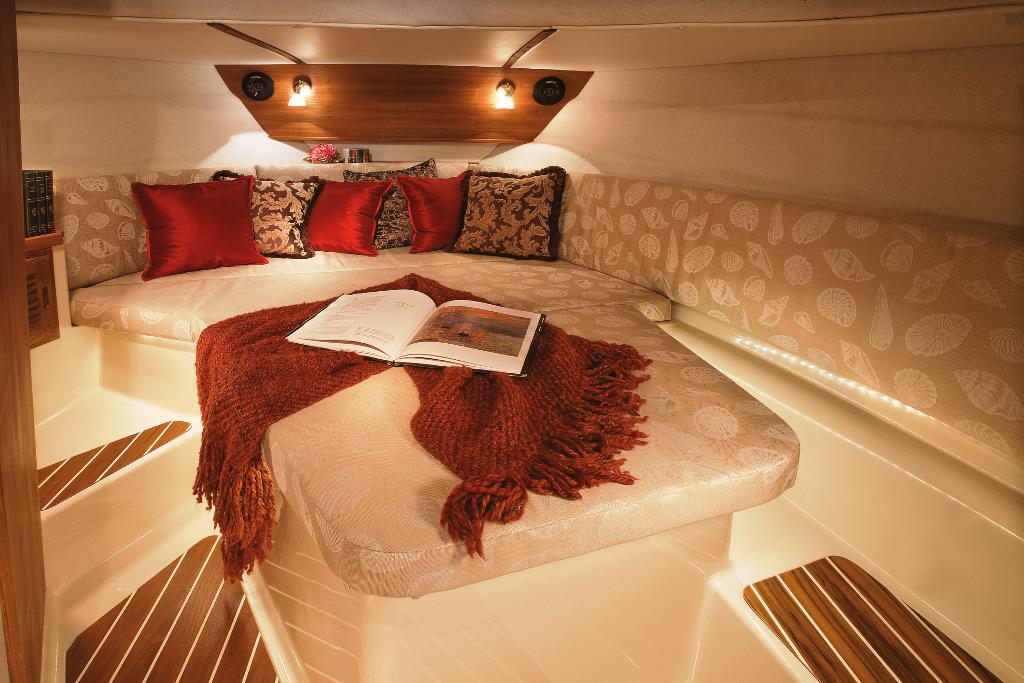
Gentle Cruiser
If you’re wanting to be in a great hurry, the R-29 is not for you, even though it’s a 22 knot boat. If you are happy to sit on a leisurely 6 knots, using a miserly 5 litres of fuel an hour, then the Ranger Tugs’ flagship is worth looking at.
Our performance figures on the day were as follows:
Idle speed at 700rpm, doing 3 knots using 1 litre of fuel per hour; 900rpm, 3.5 knots consuming 1.7L/h; 1500revs travelling at 5.3 knots using 4.5L/h; 1800rpm (which is regarded as the best cruising speed) 6.2 knots consuming 7.5L/h; 2000rpm doing 7 knots using 10.5L/h. At this point we had increased the throttle by only 200 revs but had increased the fuel burn by about 20 per cent so there was no real advantage in trying to speed. Our top speed for the day was at 3680rpm sitting on 18.4 knots and consuming 46.1L/h.
Our figures were very close to those published by Ranger Tugs and our boat test was carried out on Cockburn Sound with a tide and current running. To the west is the Indian Ocean with Garden Island offering us some protection but we are in the major shipping lanes off Fremantle with their associated environmental conditions. We are certainly not in closed waters.
Stability is excellent, both at rest and underway, and when I was moving around the boat taking photographs there was some slight listing. The stainless steel safety railing is extensive on the cabin roof and there are high side and bow rails so safe passage is assured.
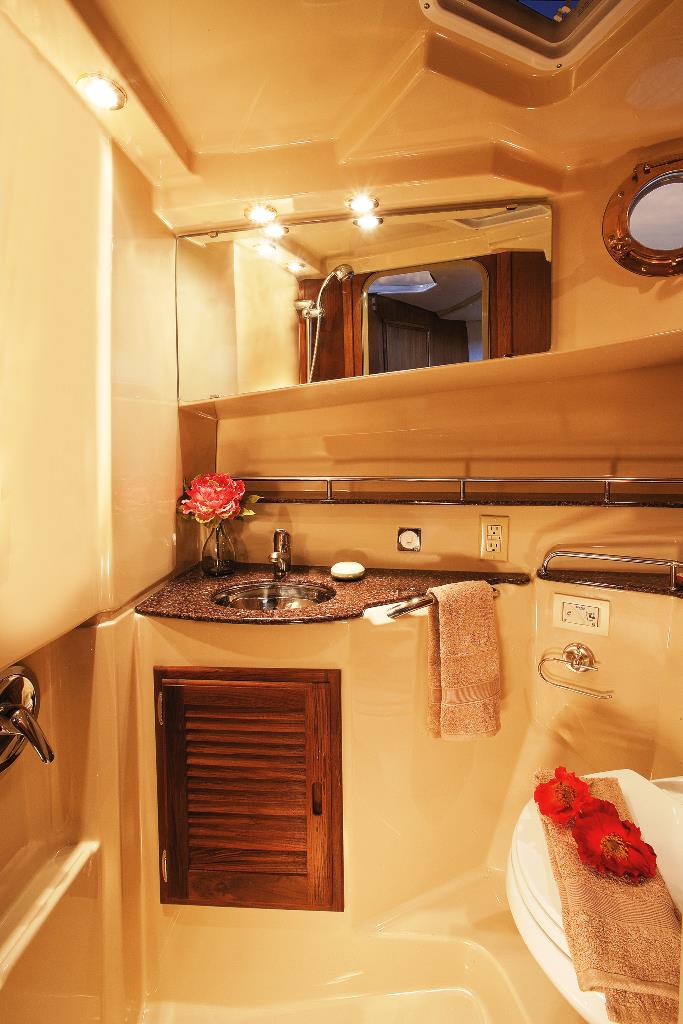
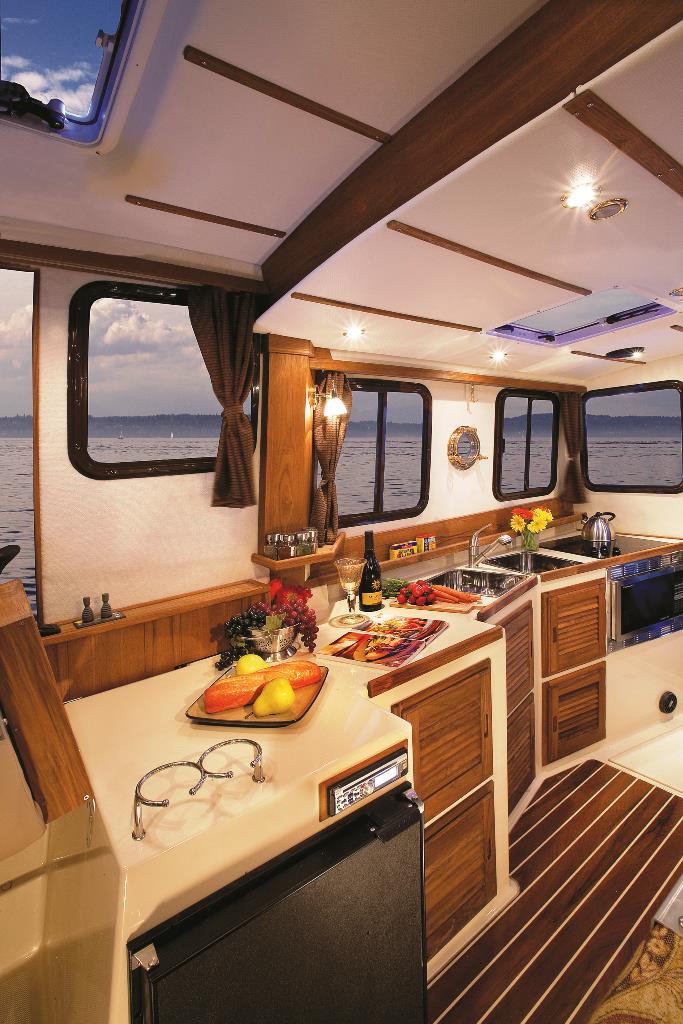
The roof also holds a stainless steel mast and large spotlight. The mast folds down for greater bridge clearance or during towing on the road.
The insulation surrounding the engine room is very effective, reducing the noise significantly with the hydraulic hatch closed. Conversation is easy whether you’re sitting in the aft cockpit or up front. For servicing and regular maintenance of the Yanmar 260hp 6 cylinder turbo-charged diesel motor, the engine room is in the middle of the cockpit floor and surprisingly roomy from all four sides. If the engine does have to be removed it’s a matter of hoisting it straight out, with no superstructure to worry about. For regular oil and coolant checks there’s a separate hatch just inside the main cabin door. There’s no need to raise the large hatch.
Well Equipped
The helm and the co-pilot’s seating are raised, giving excellent vision. There are secure stainless foot rests and the passenger seat is a bench style, able to accommodate two people. When the seat is vacant, a fold-down chart table can be deployed adjacent to the helm.
Navigation instrumentation is not fitted at the factory because buyers usually have their own brand choices, plus you get local warranties if fitted in Australia or New Zealand. In keeping with the teak timber theme throughout the interior, the dash is wood and the review boat was fitted with a flush-mounted Raymarine C-120 W GPS/Sounder combo and Garmin VHF radio.
Bow and stern thrusters come as standard equipment and the joystick control is located just to the rear of the throttle remote. The sliding door leading to the starboard side deck is to the right of the helm station and the console housing the throttle and thruster controls slides back to allow easy access through the doorway. While there is ample roof hatch ventilation in the pilot house/saloon, the open door gives more airflow and is a short cut to the bow.
It was interesting to note the compass has been installed on the outside of the windscreen in front of the helm, which leaves the timber shelf free of clutter. It’s a busy dash with all the instrumentation in good view, plus the switch panel, anchor winch, trim tabs, horn, and light controls within easy reach. The Yanmar engine management display is in large detail and easy to read at a quick glance.

Caravan Style
As mentioned earlier, the Ranger Tug’s interior is very similar to caravan style, with the dinette on the port side being collapsible to make an extra double bunk. The R-29 is the biggest in the fleet and has good room to move around, largely thanks to a beam of just over three metres.
The master stateroom is located forward and full advantage has been taken making the head of the bed wider than at the foot. The wide part doubles as seating while dressing if need be. There’s plenty of cupboard space, plus a flat screen television on the starboard bulkhead. The teak folding door gives complete privacy from the pilot house. If you don’t want the door closed there is a curtain which can be drawn for privacy but still allows access to the bathroom and day-head from the upper deck.
The bathroom is located between on the port side near the forward cabin and is surprisingly roomy, complete with electric head, vanity and full height shower.
As in a caravan dinette, there is bench seating forward and aft of the large teak table top. The back of the portside passenger seat folds forward to create the front bench seat when dining. If another double berth is required, the table top collapses on its pedestal stand.
A six-bottle wine cooler has been fitted under the forward bench seat, opposite the below-bench refrigerator in the galley section on the starboard side. For extra space during meal preparation, the skipper’s seat folds forward, giving an extra half-metre of benchtop.
The review vessel was fitted with a two-burner electric cooktop and oven, twin stainless sinks and plenty of cupboards and drawers for utensils. A microwave oven is fitted under the rear dinette bench seat. A narrow shelf runs along the starboard wall behind the benchtop, put to good use on this occasion carrying a range of cool drink stubbie holders.
The whole saloon/pilot house is flooded with natural light thanks to numerous windows, open doors and the windscreen. All the windows are sliding and fitted with insect screens, plus there is a brass porthole each side if you want the large windows closed. For night time privacy, inside curtains can be drawn, plus there are UV resistant clip-on curtains when closing the vessel up.
The R-29 has a second small cabin on the port side which can sleep a couple of ankle-biters, although the owner says he has had a couple of adults in there. Because the dinette is raised on a similar level to the helm, greater ceiling space has been created in the berth below. Access is immediately to port as you enter the main cabin and through a folding polycarbonate door. The owner was using it for storage on this occasion. Nearby is the main switch panel, clearly visible as you enter the interior, checking your battery power and other vital gauges.
The review boat was fully air conditioned, with 4.7kW in the saloon/pilot house and 2.9kW for the master stateroom.
Inviting Cockpit
At the rear the cockpit is roomy and the side walls double as stairs while boarding or alighting from the vessel. The stairs are fitted with gas struts and lift with ease, revealing battery storage on the portside and a Cummins Onan generator to starboard. The standard vessel comes with six batteries and there’s lots space in these boot-like compartments for fenders, ropes etc. and the steps double as rear seats with clip-on cushions.
The transom has a door on the starboard side, plus stainless steel sink with a hot and cold fresh water tap which doubles as a shower. There is also a wet or dry storage well. Folding lids convert the area into a large bench top space, with stainless bottle holders left and right. Three large hatches underneath provide more storage. The aft deck is large enough for a couple of folding director’s chairs and an optional barbeque could be fitted for outdoor cooking, leaving the galley free. There’s a large marlin board aft with built-in fenders and folding ladder.
It was a great pleasure to operate the R-29. The vision through the four-piece screen is excellent, the steering is very responsive and there is a clever use of space. We were in no great hurry and it was a leisurely few hours on the water. If you do work and play in the fast lane, stepping aboard the Ranger Tugs R-29 will take you back in time and it’s a sure way to lower the blood pressure at a very affordable 5 or 6 litres of fuel per hour cruising around 6 knots. Let’s face it, who’s in a hurry when surrounded by nature at its best? With the Ranger range of boats all trailerable, including the R-29 weighing just over 4 tonnes, it makes the boat-cum-caravan another option and you’re certainly getting a vessel with a difference.
TECHNICAL SPECIFICATIONS
- Boat Design Name: Ranger Tugs R-29
- Year Launched: 2011 (in Australia)
- Designer: David Livingston
- Builder: Ranger Tugs
- LOH: 8.90m
- LOA: 10.06m
- Beam: 3.05m
- Draft: .71m
- Displacement (dry): 4196 kg
- Max Speed: 24 Knots
- Cruise Speed: 6-15 Knots
- Construction: GRP
- Fuel Cap: 568 litres
- Water Cap: 265 litres
- Engines Make: Yanmar 6BY2 @ 260hp
- Base Price of Boat: $Aus335,000 inc
- Price As Tested: $Aus350,000 inc




